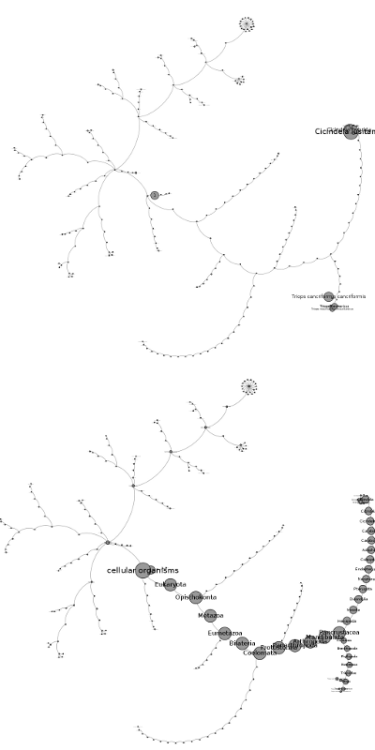Hi Biostars,
I would like to take the output of Galaxy's Metagenomic Analyses > Fetch Taxonomic representation and make a Taxonomic tree that contains abundance information. For display, I could then experiment with the the many excellent visualization softwares out there ( i am particualry interested in the ETE2 library) . This question is very similar to a previous question where the author was reccommended to use iTOL for a similar purpose. I am wondering, however, if it possible to generate an abundance-information-containing Newick tree directly from the Galaxy Metagenomic Analyses output - ideally to provide a flexible replacement for the current taxonomic abundance-visualization tool. The values in the Newick tree could actually come from the
The data output is a table with a few identifier collumns and then the kindom/phlyum/class.... Here are a few lines (sorry that it wraps):
contig00428 562 root Bacteria n n n Proteobacteria n n Gammaproteobacteria n n Enterobacteriales n n Enterobacteriaceae n n n Escherichia n Escherichia coli n 42469
contig00073 562 root Bacteria n n n Proteobacteria n n Gammaproteobacteria n n Enterobacteriales n n Enterobacteriaceae n n n Escherichia n Escherichia coli n 42945
contig00672 562 root Bacteria n n n Proteobacteria n n Gammaproteobacteria n n Enterobacteriales n n Enterobacteriaceae n n n Escherichia n Escherichia coli n 146126
contig00143 562 root Bacteria n n n Proteobacteria n n Gammaproteobacteria n n Enterobacteriales n n Enterobacteriaceae n n n Escherichia n Escherichia coli n 287840
contig01215 562 root Bacteria n n n Proteobacteria n n Gammaproteobacteria n n Enterobacteriales n n Enterobacteriaceae n n n Escherichia n Escherichia coli n 290448
Alternatively the 'Summarize Taxonomy tool' provides the following:
superkingdom Eukaryota 9
superkingdom Viruses 1
kingdom Fungi 2
kingdom Metazoa 5
kingdom Viridiplantae 1
subkingdom Dikarya 2
superphylum Bacteroidetes/Chlorobi group 22
superphylum Chlamydiae/Verrucomicrobia group 6
superphylum Fibrobacteres/Acidobacteria group 8
phylum Acidobacteria 8
phylum Actinobacteria 9
phylum Apicomplexa 1
any ideas would be appreciated, zach cp



Zach, how big (# of terminal nodes) are your trees?
jhc, the tree varies depending on the experiment but a few thousand is typical. I actually came across your Taxonomy Lookup and have been playing with it. It is similar to Pierre's but outputs the newick tree which I can then use with the ETE2 library for custom layout. (which is awesome - thanks!).